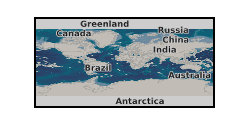Proterozoic
Type of resources
Available actions
Topics
Keywords
Contact for the resource
Provided by
Years
Formats
Update frequencies
-

Geochemical measurements which quantify the lithium isotope ratios (d7Li) of Paleozoic (541–251 Mya) mudstones. Samples were obtained from various field locations across Scotland, Wales, England and New Brunswick, Nova Scotia, Canada. Sampled mudstones are listed under their formation name, with information on the locations of each outcrop belt and further details on lithological characteristics, including environment of formation, freely available on the British Geological Survey Lexicon of named rock units (https://www.bgs.ac.uk/technologies/the-bgs-lexicon-of-named-rock-units/) and Government of Canada weblex (https://weblex.canada.ca/weblexnet4/weblex_e.aspx), for UK and Canadian samples, respectively. Stratigraphic age is given in accordance to the GSA geological timescale v.5.0. Following sampling, specific methodologies for preparation for Lithium isotope analysis are provided in the Metadata Lineage. The data was collected to understand changes in weathering intensity coeval with the Paleozoic expansion of land plants, with lithium isotopes a powerful trace for silicate weathering as they are sensitive to the balance between rock dissolution and clay formation. The tabulated lithium isotope ratios were compared at different temporal stages of plant evolution through the Paleozoic. Samples were collected by the University of Cambridge. Lithium isotope ratios were obtained by William McMahon and supervised by Edward Tipper and Mohd Tarique. Mass spectrometry was carried out by William McMahon and David Wilson at University College London.
-

The stratigraphic scope of the data is 1) the Polarisbreen Group of NE Svalbard (late Tonian to Ediacaran) and 2) top Appin and lower Argyll Groups, western Scotland (late Tonian to Cryogenian). Geochemical data on carbonates includes, in different cases, stable oxygen and carbon isotopes, strontium isotopes and trace elements. Results from Scotland are published in: Fairchild, I.J., Spencer, A.M., Ali, D.O., Anderson, R.P., Anderton, R., Boomer, I., Dove, D., Evans, J.D., Hambrey, M.J., Howe, J., Sawaki, Y., Wang, Z., Shields, G., Skelton, A. Tucker, M.E. and Zhou, Y. 2017 Tonian-Cryogenian boundary sections of Argyll, Scotland. Precambrian Research. doi: 10.1016/j.precamres.2017.09.020. An additional plot of some of the data is in: Ali, D.O., Spencer, A.M., Fairchild, I.J., Chew, K.J., Anderton, R., Levell, B.K., Hambrey, M.J., Dove, D., Le Heron, D.P. 2018. Indicators of relative completeness of the glacial record of the Port Askaig Formation, Garvellach Islands, Scotland. Precambrian Research. Doi: 10.1016/j.precamres.2017.12.005. Results from Svalbard are partly published (Elbobreen Formation, members 3 and 4; Wilsonbreen Formation) in the publications listed below. Data on Elbobreen Formation, members 1 and 2 and the Dracoisen Formation are not published at the time of writing (January 2018). Fairchild, I.J., Bonnand, P., Davies, T., Fleming, E.J., Grassineau, N., Halverson, G.P., Hambrey, M.J., McMillan, E.A., McKay, E., Parkinson, I.J. and Stevenson, C.T.E. 2016 The Late Cryogenian Warm Interval, NE Svalbard: chemostratigraphy and genesis of dolomitic shales. Precambrian Research, 281, 128-154. Fairchild, I.J., Fleming, E.J., Bao, H., Benn, D.I., Boomer, I., Dublyansky, Y.V., Halverson, G.P., Hambrey, M.J., Hendy, C., McMillan, E.A., Spötl, C., Stevenson, C.T.E. and Wynn, P.M. 2016 Continental carbonate facies of a Neoproterozoic panglaciation, NE Svalbard. Sedimentology, 63, 443-497. Benn, D.I., Le Hir, G., Bao, H., Donnadieu, Y., Dumas, C., Fleming, E.J., Hambrey, M.J., McMillan, E.A., Petronis, M.S., Ramstein, G., Stevenson, C.T.E., Wynn, P.M. and Fairchild, I.J. 2015 Orbitally forced ice sheet fluctuations at the end of the Marinoan Snowball Earth glaciation Nature Geoscience. 8, 704-707. Fleming, E.J. (2014) Magnetic, Structural and Sedimentological Analysis of Glacial Sediments: Insights from Modern, Quaternary and Neoproterozoic Environments. Unpublished PhD Thesis. University of Birmingham. Available at: http://etheses.bham.ac.uk/5136/
-

Data and associated papers. Ocean acidification and the Permo-Triassic mass extinction. Ediacaran metazoan reefs from the Nama Group, Namibia. NERC Grant Re-inventing the planet: The Neoproterozoic revolution in oxygenation, biogeochemistry and biological complexity.
 NERC Data Catalogue Service
NERC Data Catalogue Service